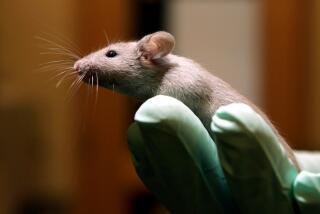Human Fetus Cells Used in Brain Grafts on Lab Animals
- Share via
ROCHESTER, N.Y. — Scientists experimenting with brain grafts to treat Parkinson’s disease patients have taken a major but possibly controversial step forward by using human fetal cells to treat laboratory animals.
Their research brings closer the day when fetal cells--taken from aborted fetuses--might be used to treat humans who suffer from this debilitating disease. But that day is still at least a year off, according to experts attending an international meeting on brain grafting here.
A growing number of Parkinson’s researchers around the world are transplanting tissues from patients’ own adrenal glands into their brains in an attempt to reduce the severe tremors and rigidity of limbs associated with the disease. At least 44 patients in five countries have received the experimental therapy, scientists reported here.
Many of the patients have shown dramatic improvements in their condition, as evidenced by videotapes shown be researchers from Beijing, Mexico City, and Nashville, Tenn.
But most of the patients were under age 55, whereas most Parkinson’s victims are over age 60, and experts believe that adrenal glands do not work as well as they become aged.
Thus scientists in lab experiments are turning to cells taken from aborted fetuses for grafting.
Parkinson’s is caused by the death of brain cells that secrete dopamine, which carries messages between brain cells. Some cells in the hormone-producing adrenal gland also secrete dopamine. When such a gland is removed from its normal site over the kidneys, cut into small pieces and then transplanted into the brain, it secretes dopamine to replace that lost by the death of the brain cells.
But many experiments in animals have shown that adrenal glands from older animals are less effective than those from younger animals in alleviating Parkinson’s symptoms.
Neurologist Vincenzo Silani of the University of Milan in Italy reported on Wednesday that a monkey’s Parkinson’s symptoms were alleviated after he implanted in its brain human adrenal cells obtained from aborted fetuses. He said the fetal cells were obtained from local abortion clinics after receiving the permission of the abortion patients.
Silani said he used adrenal cells rather than the brain cells from the fetus because the former are easier to isolate. Most scientists say they would prefer fetal brain cells because they are most like the cells they would replace.
Two groups from Sweden reported that they had alleviated Parkinson’s symptoms in rats by implanting human fetal brain cells. “Most aborted fetuses in Sweden are used for research,” said neurologist Patrick Brundin of the University of Lund.
Although the experiments were successful, ethical and practical problems must be solved before fetal cells can be used in humans, Brundin said. Many ethicists fear, for example, that a woman might get pregnant, then have an abortion so that a family member with Parkinson’s could be treated.
Among the practical problems is that a recipient of fetal cells would have to be treated with potentially dangerous immune-suppressing drugs, just like a heart transplant patient.
Meanwhile, the number of adrenal tissue transplants in human Parkinson’s patients continues to grow, with 44 reported at the meeting here. They have been performed by neurosurgeons in Mexico City, Beijing, Stockholm, Havana, Cuba; Nashville, Chicago and Tampa.
The current rush was touched off by an April report in the New England Journal of Medicine by Dr. Ignacio Madrazo of Centro Medico La Raza in Mexico City that transplanting adrenal cells into the brain produced remarkable improvement in two Parkinson’s patients.
On Tuesday, his colleague, Rene Drucker-Colin of the University of Mexico City, reported that they now have treated 18 patients in all, and that 15 of them have shown dramatic improvement. For example, the researchers showed videotape of patients who could not walk or even feed themselves before the brain grafts. After the operations, many of the patients became self-sufficient.






